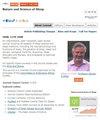Nonlinear Heart Rate Variability Analysis for Sleep Stage Classification Using Integration of Ballistocardiogram and Apple Watch
IF 3.4
2区 医学
Q2 CLINICAL NEUROLOGY
引用次数: 0
Abstract
Purpose: Wearable or non-contact, non-intrusive devices present a practical alternative to traditional polysomnography (PSG) for daily assessment of sleep quality. Physiological signals have been known to be nonlinear and nonstationary as the body adapts to states of rest or activity. By integrating more sophisticated nonlinear methodologies, the accuracy of sleep stage identification using such devices can be improved. This advancement enables individuals to monitor and adjust their sleep patterns more effectively without visiting sleep clinics.Patients and Methods: Six participants slept for three cycles of at least three hours each, wearing PSG as a reference, along with an Apple Watch, an actigraphy device, and a ballistocardiography (BCG) bed sensor. The physiological signals were processed with nonlinear methods and trained with a long short-term memory (LSTM) model to classify sleep stages. Nonlinear methods, such as return maps with advanced techniques to analyze the shape and asymmetry in physiological signals, were used to relate these signals to the autonomic nervous system (ANS). The changing dynamics of cardiac signals in restful or active states, regulated by the ANS, were associated with sleep stages and quality, which were measurable.
Results: Approximately 73% agreement was obtained by comparing the combination of the BCG and Apple Watch signals against a PSG reference system to classify rapid eye movement (REM) and non-REM sleep stages.
Conclusion: Utilizing nonlinear methods to evaluate cardiac dynamics showed an improved sleep quality detection with the non-intrusive devices in this study. A system of non-intrusive devices can provide a comprehensive outlook on health by regularly measuring sleeping patterns and quality over time, offering a relatively accessible method for participants. Additionally, a non-intrusive system can be integrated into a user’s or clinic’s bedroom environment to measure and evaluate sleep quality without negatively impacting sleep. Devices placed around the bedroom could measure user vitals over longer periods with minimal interaction from the user, representing their natural sleeping trends for more accurate health and sleep disorder diagnosis.
Keywords: ballistocardiogram, wearable, heart rate variability, nonstationary signals
利用球形心动图和 Apple Watch 集成非线性心率变异性分析进行睡眠阶段分类
目的:可穿戴或非接触、非侵入式设备是传统多导睡眠图(PSG)的实用替代品,可用于日常睡眠质量评估。众所周知,生理信号在人体适应休息或活动状态时是非线性和非稳态的。通过整合更复杂的非线性方法,可以提高使用此类设备识别睡眠阶段的准确性。这一进步能让个人在不去睡眠诊所的情况下更有效地监测和调整自己的睡眠模式:六名参与者在佩戴 PSG 作为参考的同时,还佩戴了 Apple Watch、动图设备和球心动图(BCG)床传感器,进行了三个周期的睡眠,每个周期至少三小时。生理信号采用非线性方法进行处理,并使用长短期记忆(LSTM)模型进行训练,以对睡眠阶段进行分类。非线性方法,如采用先进技术分析生理信号的形状和不对称的返回图,用于将这些信号与自律神经系统(ANS)联系起来。在自律神经系统的调节下,静息或活跃状态下心脏信号的动态变化与睡眠阶段和质量相关联,而睡眠阶段和质量是可以测量的:通过将 BCG 和 Apple Watch 信号组合与 PSG 参考系统进行比较,得出了约 73% 的一致性,从而对快速眼动(REM)和非快速眼动睡眠阶段进行了分类:利用非线性方法评估心脏动力学显示,本研究中的非侵入式设备提高了睡眠质量检测的效率。非侵入式设备系统可通过定期测量睡眠模式和睡眠质量,为参与者提供一种相对容易获得的方法,从而提供全面的健康展望。此外,非侵入式系统可以集成到用户或诊所的卧室环境中,在不对睡眠产生负面影响的情况下测量和评估睡眠质量。放置在卧室周围的设备可以在较长时间内测量用户的生命体征,而用户只需极少的互动,就能代表他们的自然睡眠趋势,从而更准确地诊断健康和睡眠障碍。
本文章由计算机程序翻译,如有差异,请以英文原文为准。
求助全文
约1分钟内获得全文
求助全文
来源期刊

Nature and Science of Sleep
Neuroscience-Behavioral Neuroscience
CiteScore
5.70
自引率
5.90%
发文量
245
审稿时长
16 weeks
期刊介绍:
Nature and Science of Sleep is an international, peer-reviewed, open access journal covering all aspects of sleep science and sleep medicine, including the neurophysiology and functions of sleep, the genetics of sleep, sleep and society, biological rhythms, dreaming, sleep disorders and therapy, and strategies to optimize healthy sleep.
Specific topics covered in the journal include:
The functions of sleep in humans and other animals
Physiological and neurophysiological changes with sleep
The genetics of sleep and sleep differences
The neurotransmitters, receptors and pathways involved in controlling both sleep and wakefulness
Behavioral and pharmacological interventions aimed at improving sleep, and improving wakefulness
Sleep changes with development and with age
Sleep and reproduction (e.g., changes across the menstrual cycle, with pregnancy and menopause)
The science and nature of dreams
Sleep disorders
Impact of sleep and sleep disorders on health, daytime function and quality of life
Sleep problems secondary to clinical disorders
Interaction of society with sleep (e.g., consequences of shift work, occupational health, public health)
The microbiome and sleep
Chronotherapy
Impact of circadian rhythms on sleep, physiology, cognition and health
Mechanisms controlling circadian rhythms, centrally and peripherally
Impact of circadian rhythm disruptions (including night shift work, jet lag and social jet lag) on sleep, physiology, cognition and health
Behavioral and pharmacological interventions aimed at reducing adverse effects of circadian-related sleep disruption
Assessment of technologies and biomarkers for measuring sleep and/or circadian rhythms
Epigenetic markers of sleep or circadian disruption.
 求助内容:
求助内容: 应助结果提醒方式:
应助结果提醒方式:


